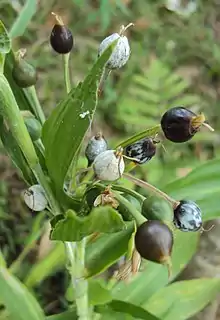Coix
Coix /ˈkoʊɪks/ is a genus of Asian and Australian plants in the grass family.[3][4]
| Coix | |
|---|---|
 | |
| Coix lacryma-jobi | |
| Scientific classification | |
| Kingdom: | Plantae |
| Clade: | Tracheophytes |
| Clade: | Angiosperms |
| Clade: | Monocots |
| Clade: | Commelinids |
| Order: | Poales |
| Family: | Poaceae |
| Subfamily: | Panicoideae |
| Supertribe: | Andropogonodae |
| Tribe: | Andropogoneae |
| Subtribe: | Coicinae Rchb. ex Clayton & Renvoize |
| Genus: | Coix L. |
| Type species | |
| Coix lacryma-jobi | |
| Synonyms[2] | |
| |
The best-known species is Coix lacryma-jobi, widely called Job's tears. Its variety Coix lacryma-jobi var. ma-yuen is cultivated in many warm regions as a source of food, medicine, and ornamentation.[5][6]
The generic name is from Ancient Greek κόϊξ (koix), which originally referred to the doum palm (Hyphaene thebaica); the fruits of the doum palm resemble the diaspores of Coix.[7]
Species
- Coix aquatica Roxb. - China (Yunnan, Guangdong, Guangxi), Indian Subcontinent, Indochina, Peninsular Malaysia; naturalized in New Guinea
- Coix gasteenii B.K.Simon - northern Queensland
- Coix lacryma-jobi L. - China , Indian Subcontinent, Southeast Asia; naturalized in other parts of Asia as well as in southern Europe, Africa, the Americas, and various oceanic islands
Formerly Included
[2] see Chionachne Polytoca Tripsacum
- Coix angulata - Tripsacum dactyloides
- Coix barbata - Chionachne gigantea
- Coix crypsoides - Chionachne gigantea
- Coix dactyloides - Tripsacum dactyloides
- Coix gigantea J.Koenig 1788 not J.Koenig ex Roxb. 1932 - Chionachne gigantea
- Coix heteroclita - Polytoca digitata
- Coix koenigii - Chionachne gigantea
- Coix sulcata - Chionachne punctata
Formerly included in
This genus was formerly placed in the Maydeae, now known to be polyphyletic.[Sch 1]
Proteins and expression
Members of this genus produce their own variety of α-zein prolamins. These prolamins have undergone unusually rapid evolutionary divergence from closely related grasses, by way of copy-number changes.[Sch 2]
References
- lectotype designated by Green, Prop. Brit. Bot.: 187 (1929)
- "World Checklist of Selected Plant Families: Royal Botanic Gardens, Kew". wcsp.science.kew.org.
- Linnaeus, Carl von. 1753. Species Plantarum 2: 972 in Latin
- "Tropicos". www.tropicos.org.
- Hill,A.F. 1952. Economic Botany, McGraw-Hill
- Arora, R. K., 1977, "Job's tears (Coix lacryma-jobi) - a minor food and fodder crop of northeastern India." Economic Botany, Volume 31, issue 3, pages 358–366.
- Clifford, Harold T.; Bostock, Peter D. (May 16, 2007). Etymological Dictionary of Grasses. Springer Science & Business Media. ISBN 9783540384342 – via Google Books.
- "Search results — The Plant List". www.theplantlist.org.
- Schnable, James C. (2015-04-29). "Genome Evolution in Maize: From Genomes Back to Genes". Annual Review of Plant Biology. Annual Reviews. 66 (1): 329–343. doi:10.1146/annurev-arplant-043014-115604. ISSN 1543-5008. PMID 25494463.
- p. 331, "Maize and Tripsacum were previously grouped with a number of other grasses that have monoecious flowering patterns — the most widely known being Job’s tears (Coix lacryma-jobi) — into the Maydeae (74); however, molecular data revealed that this grouping was polyphyletic (61)."
- p. 335, "Clusters of locally duplicated genes can also expand and contract rapidly, as shown by investigation of the 22-kDa α zein gene families in maize, sorghum, and coix, which appear to have experienced independent copy-number amplifications since the divergence of these three species (107)."